› Forums › General Discussion › Betelgeuse
Tagged: Betelgeuse Leona occultation
- This topic has 97 replies, 23 voices, and was last updated 4 months, 3 weeks ago by
 Robin Leadbeater.
Robin Leadbeater.
-
AuthorPosts
-
2 January 2020 at 8:15 pm #581865
 Robin LeadbeaterParticipant
Robin LeadbeaterParticipantNo the individual lines cannot be resolved (Even if the spectrometer had enough resolution they would be broadened in the stellar spectrum to the point where they merged). The depth of the merged bands however gives a measure of the spectral class and therefore Teff even in low resolution spectra. The referenced Atel for example just used photometry in a particular targeted 705nm waveband to estimate the temperature change.
“Measures of Wing TiO-band (705 nm) and near-IR colors indicate that currently Betelgeuse has relatively strong TiO-bands and has a corresponding lower photospheric temperature of T~3580 K (relative to T~ 3660 K near maximum brightness”
2 January 2020 at 8:36 pm #581866 Robin LeadbeaterParticipant
Robin LeadbeaterParticipantHere for example is a comparison of standard spectra for M2iii (blue Teff 3600K) compared with M6iii (pink Teff 3100K)
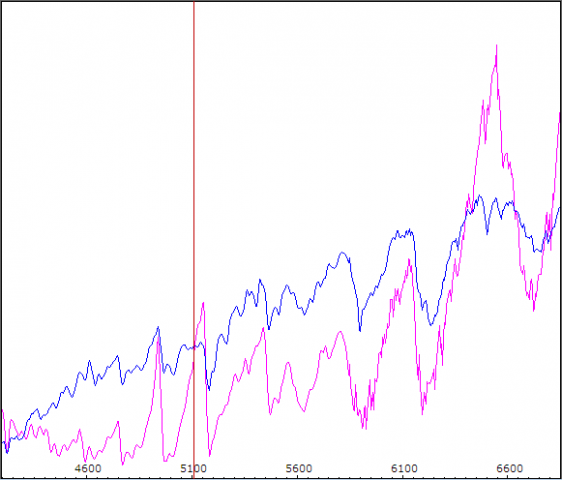 3 January 2020 at 12:25 pm #581867
3 January 2020 at 12:25 pm #581867 Andy WilsonKeymaster
Andy WilsonKeymasterBetelgeuse is a cool red star with the majority of its flux in the red and infrared, while the majority of observations are visual or with a V filter. It occurred to me the widely discussed drop in luminosity is based on the assumption that what is happening in the visual represents the total luminosity of the star, and this might not be the case. I decided to do a little investigation using spectra from the BAA Spectroscopy Database and V filter magnitudes from the AAVSO International Database to do a rough flux calibration of the spectra.
My first plot shows what passes through a V filter using James Foster’s spectrum from 9th April 2018. You can see the V filter is most sensitive to wavelengths where Betelgeuse is not at its brightest. The V filter is approximately like human vision, not a perfect match but reasonable. You can also see how the flux continues to rise to shorter wavelengths towards the infrared.
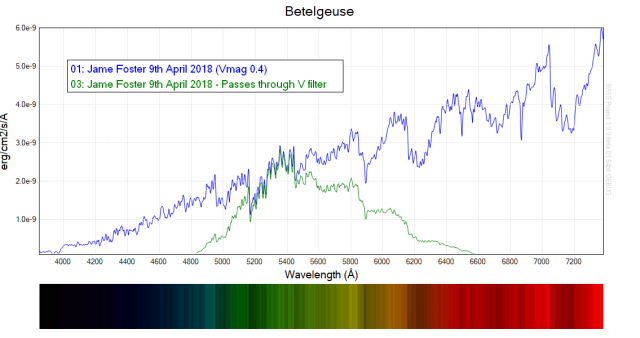
Next I compared James Foster’s spectrum from 9th April 2018 to Robin Leadbeater’s recent spectrum from 30th December 2019. The approximate V magnitudes on these dates are 0.4 and 1.4, though due to difficulties with measuring the luminosity of Betelgeuse it is best to consider these with uncertainties of +/-0.1 magnitudes. A magnitude of 0.4 is fairly typical of Betelgeuse in recent years, noting it regularly varies by nearly a magnitude. I did a flux calibration using the V filter profile rather than any specific representative wavelength. This was to avoid any effects due to individual lines skewing the results. This shows a very marked drop in luminosity to longer wavelengths up to at least 7400 Angstroms.
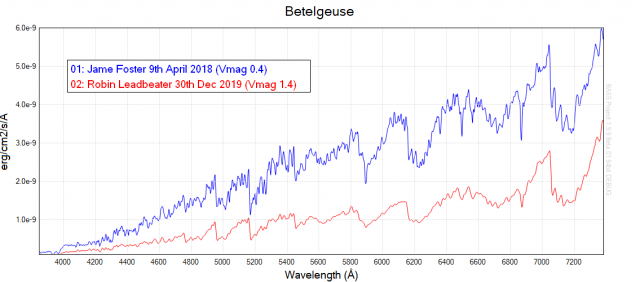
Their aren’t spectra in the BAA database with longer wavelengths into the infrared due to the difficulty in making these measurements. So instead I then compared Pickles reference spectra for M2 and M4 (both at luminosity class III). These aren’t perfect matches to James and Robin’s spectra but they are good enough for a first approximation (M2 typical and M4 now). It can be seen that a drop in luminosity at shorter wavelengths in the visual region does not necessary continue to longer wavelengths, with the flux being about the same from about 8000 Angstroms. These spectra only go to 10,000 Angstroms, but give a hint of stronger flux deeper into the infrared for the cooler M4 spectrum. So I wonder whether the total luminosity has not dropped by as much as it appears. Perhaps some or most of the flux has shifted from the visual into the infrared?
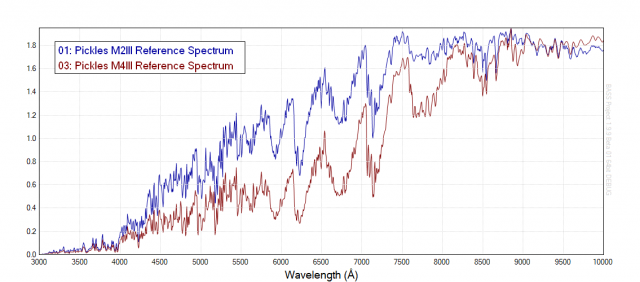
Comments and criticism welcome 🙂
3 January 2020 at 2:17 pm #581868 Robin LeadbeaterParticipant
Robin LeadbeaterParticipantHi Andy,
Good point. The V (and R) band does seem to sit in a region which is particularly sensitive to the degree of molecular band absorption which in turn is sensitive to temperature. That additional absorbed flux has to end up elsewhere in the spectrum, most likely in the IR so changes in V mag probably do overestimate the change in total flux as you say.
3 January 2020 at 2:44 pm #581869 Robin LeadbeaterParticipant
Robin LeadbeaterParticipantThe latest Atel from the team who originally announced the dimming has some figures on photosphere temperature changes based on IR Wing band filters. They seem to tally reasonably with our estimates from the spectrum change
8 January 2020 at 2:06 pm #581878 Robin LeadbeaterParticipant
Robin LeadbeaterParticipantIt does indeed seem the fading of Betelgeuse has indeed been greatly exaggerated
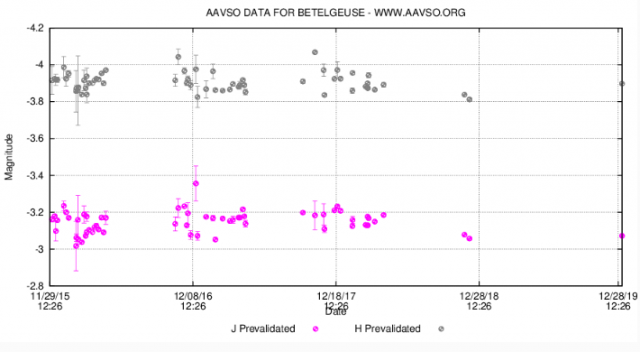
I see there is now a recent H,J point in the AAVSO database (The first for over a year)
It shows that Betelgeuse is not fading in the IR where most of the flux is so it does suggest there has not been any significant drop in bolometric luminosity, just a small drop in temperature which has produced an exaggerated effect at V mag, a region sensitive to changes in the depth of the molecular absorption bands.
Cheers
Robin
8 January 2020 at 2:28 pm #581881 Andy WilsonKeymaster
Andy WilsonKeymasterThanks for sharing this Robin. When I first looked on the AAVSO database there were no recent IR measurements, it is great these have been added.
I agree this implies a cooling rather than a change in total luminosity (bolometric).
It is possible the star may have expanded a little rather than contracted as I have seen some saying, to explain the cooling. Though that is pure speculation on my part. A more detailed analysis of the existing data and ideally additional spectra in the IR would help to tie down the change in bolometric luminosity and temperature, to then understand if it has changed size.
Cheers,
Andy
22 January 2020 at 2:19 pm #581945 Robin LeadbeaterParticipant
Robin LeadbeaterParticipantI am now picking up some evolution in my spectra since the start of the year. The relative flux around 7500A has been increasing compared with that at 5500A. This is consistent with the brightness in V dropping more than in the IR
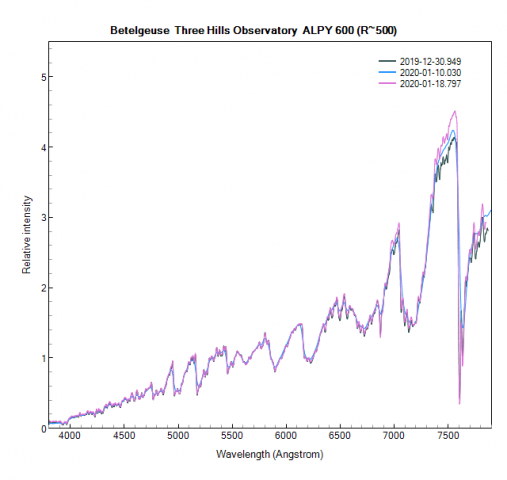 22 January 2020 at 2:30 pm #581946
22 January 2020 at 2:30 pm #581946 Robin LeadbeaterParticipant
Robin LeadbeaterParticipantHere is the latest Atel on the subject
http://www.astronomerstelegram.org/?read=13410
“The recent changes defined by our V-band/Wing photometry seem best explained from changes in the envelop-outer convection atmosphere of this pulsating, unstable supergiant. If these recent light changes are due to an extra-large amplitude light pulse on the ~420-day period, then the next mid-light minimum is expected during late January/early February, 2020. If Betelgeuse continues to dim after that time then other possibilities will have to be considered. The unusual behavior of Betelgeuse should be closely watched.”
3 February 2020 at 3:23 am #582003 Jeremy ShearsParticipant
Jeremy ShearsParticipantA new BAA VSS visual chart for Betelgeuse has been prepared by John Toone and is available in the original article on the fading of this star. Unusually, this is an 80 degree chart, which includes many of the bright stars in the winter sky. You can also download the chart directly from the VSS website.
The latest observation in the BAA VSS database has the star a mag 1.6 (Gary Poyner, Jan 28, visual).
Further observations are encouraged to see whether the fade is actually bottoming out.
3 February 2020 at 7:03 am #582005 Jeremy ShearsParticipant
Jeremy ShearsParticipantAccording to a very recent paper by Constantino Sigismondi, his analyses of its light curve variously predict minimum sometime between Jan 22 and Feb 1. Time will tell whether reality bares this out.
3 February 2020 at 9:03 am #582006 Alex PrattParticipant
Alex PrattParticipantAmerican media inform us that Betelgeuse is ‘fainting’, so perhaps we need some interstellar smelling salts to help it recover from its current swoon…
4 February 2020 at 3:42 am #582008 Jeremy ShearsParticipant
Jeremy ShearsParticipantA workshop was organised by Prof. Costantino Sigismondi in Italy a couple of weeks ago to discuss Betelgeuse’s dimming. I’m told that a video of the event will be posted on its website, but it’s not there yet. Worth keeping an eye out for. In the meantime I have asked Constantino for more info…
7 February 2020 at 12:02 am #582012 Robin LeadbeaterParticipant
Robin LeadbeaterParticipantThe plot updated with a spectrum from 2020-02-04 showing continuing evolution in the red
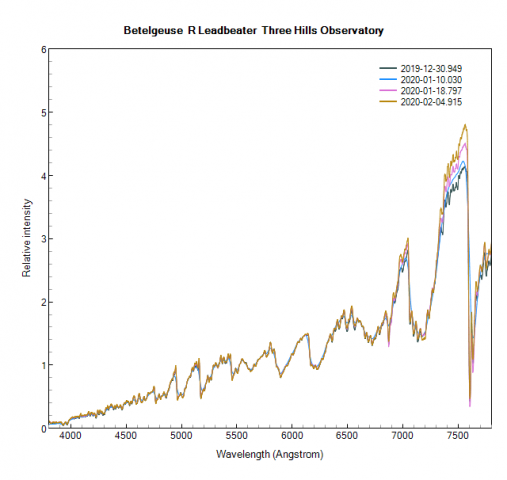 13 February 2020 at 3:12 am #582025
13 February 2020 at 3:12 am #582025 Jeremy ShearsParticipant
Jeremy ShearsParticipantConstantino Sigismondi has sent me the link to the international workshop on Betelgeuse.
This is a “virtual” workshop in which Most of the speakers are beamed in via telecon, so the quality is a bit variable….
13 February 2020 at 3:12 am #582026 Jeremy ShearsParticipant
Jeremy ShearsParticipantConstantino Sigismondi has sent me the link to the international workshop on Betelgeuse.
This is a “virtual” workshop in which Most of the speakers are beamed in via telecon, so the quality is a bit variable….
13 February 2020 at 10:50 am #582027 Gary PoynerParticipant
Gary PoynerParticipantThis is a 10d mean visual and V-band light curve for Betelgeuse since the start of the year – taken from the AAVSO light curve generator. The trend is still slightly downwards, but perhaps levelling out.
Gary
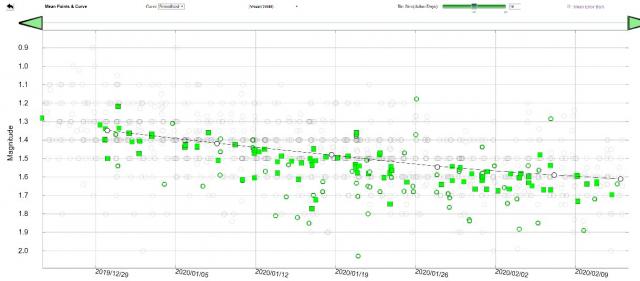 14 February 2020 at 2:20 pm #582029
14 February 2020 at 2:20 pm #582029 Derek RobsonParticipant
Derek RobsonParticipantHi Alex
I’ve been occasionally looking at Orion clips on my meteor video camera. I started to see some dimming of Betelgeuse last year and since then, it was evident just comparing with Rigel. But last night and Wed morning, I thought?? I noticed Betelgeuse looked as if it was getting brighter again. Anyone notice something like this in the last 24 hours?
14 February 2020 at 4:26 pm #582030 Mr Jack MartinParticipant
Mr Jack MartinParticipantDue to dimming, is it changing its spectral type ?
Regards,
Jack
Essex
14 February 2020 at 7:52 pm #582032 Peter MulliganParticipant
Peter MulliganParticipantHigh resolution images of Betelgeuse are available on the ESO website showing before and after images of the surface taken with the Sphere instrument .Could it be dust that is causing the dimming. hears the link https://www.eso.org/public/news/eso2003/?utm_source=feedburner&utm_medium=feed&utm_campaign=Feed%3A+EsoTopNews+%28ESO+Top+News%29
Peter
-
AuthorPosts
- You must be logged in to reply to this topic.
